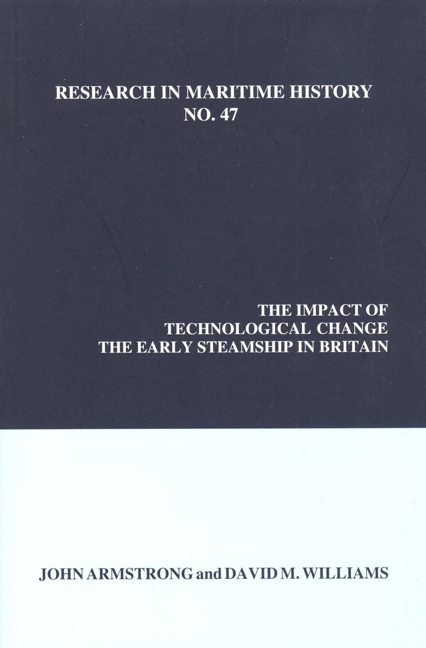Book contents
- Frontmatter
- Contents
- Series Editor's Foreword
- About the Authors
- Introduction
- Chapter 1 British Steam Navigation, 1812 to the 1850s: A Bibliographical and Historiographical Review
- Chapter 2 Some Official Listings of “Vessels Navigated by Steam” in Britain up to 1851: Evidence and Interpretation
- Chapter 3 The Steamboat, Safety and the State: Government Reaction to New Technology in a Period of Laissez-Faire
- Chapter 4 The Steamboat and Popular Tourism
- Chapter 5 The Thames and Recreation, 1815-1840
- Chapter 6 Steam Shipping and the Beginnings of Overseas Tourism: British Travel to North Western Europe, 1820-1850
- Chapter 7 Technological Advance and Innovation: The Diffusion of the Early Steamship in the United Kingdom, 1812-1834
- Chapter 8 The Steamship as an Agent of Modernisation, 1812-1840
- Chapter 9 “A New and Very Modern Business:” The Traffic and Operations of the Early Steamship
- Chapter 10 Promotion, Speculation and Their Outcome: The “Steamship Mania” of 1824-1825
- Chapter 11 The Perception and Understanding of New Technology: A Failed Attempt to Establish Transatlantic Steamship Liner Services, 1824-1828
- Chapter 12 The “Norwich Explosion” of 1817: A Local Tragedy of National Significance
- Chapter 13 Early Steamboat Services and Their Impact in North Wales, 1817-1840s
- Chapter 14 The Beginnings of a New Technology: The Constructors of Early Steamboats, 1812-1822
Chapter 2 - Some Official Listings of “Vessels Navigated by Steam” in Britain up to 1851: Evidence and Interpretation
- Frontmatter
- Contents
- Series Editor's Foreword
- About the Authors
- Introduction
- Chapter 1 British Steam Navigation, 1812 to the 1850s: A Bibliographical and Historiographical Review
- Chapter 2 Some Official Listings of “Vessels Navigated by Steam” in Britain up to 1851: Evidence and Interpretation
- Chapter 3 The Steamboat, Safety and the State: Government Reaction to New Technology in a Period of Laissez-Faire
- Chapter 4 The Steamboat and Popular Tourism
- Chapter 5 The Thames and Recreation, 1815-1840
- Chapter 6 Steam Shipping and the Beginnings of Overseas Tourism: British Travel to North Western Europe, 1820-1850
- Chapter 7 Technological Advance and Innovation: The Diffusion of the Early Steamship in the United Kingdom, 1812-1834
- Chapter 8 The Steamship as an Agent of Modernisation, 1812-1840
- Chapter 9 “A New and Very Modern Business:” The Traffic and Operations of the Early Steamship
- Chapter 10 Promotion, Speculation and Their Outcome: The “Steamship Mania” of 1824-1825
- Chapter 11 The Perception and Understanding of New Technology: A Failed Attempt to Establish Transatlantic Steamship Liner Services, 1824-1828
- Chapter 12 The “Norwich Explosion” of 1817: A Local Tragedy of National Significance
- Chapter 13 Early Steamboat Services and Their Impact in North Wales, 1817-1840s
- Chapter 14 The Beginnings of a New Technology: The Constructors of Early Steamboats, 1812-1822
Summary
In the literature on the steamship before about 1850, certain themes have received greater attention than others. Popular areas of study have included the growing sophistication of steamship technology and the development of services on particular routes. Within the latter, there has been a fascination not only with long-distance services (notably transatlantic and East Asian) but also, in the British context, many detailed studies of steam shipping on shorter routes, such as cross-Channel or cross-Irish Sea. Domestic regional surveys have proved popular, although these usually embrace a longer time scale. What has not been a feature, though, is statistical analysis. We have undertaken statistical surveys of the early steamship, but only within the first twenty years or so. There has been little or no detailed quantitative consideration of the steamship up to the mid-nineteenth century. Indeed, in contributions during the past fifty years or so, most writers have been content to rely on the limited figures of total steamboat numbers and tonnage in B.R. Mitchell and Phyllis Deane's Abstract of British Historical Statistics, published in 1962. This neglect is somewhat surprising because the Parliamentary Papers contain some valuable lists of individual steamships. These are dated 1829, 1835, 1845 and 1851 and have been little utilized.
An important aspect of these lists is that they were not regularly scheduled statements; rather, they were “one-off returns specifically requested by the House of Commons and specially produced by the Registrar of Shipping. In consequence, they represent surveys of steam shipping in Britain at a point in time rather than at the end of a calendar year. The unique feature of these surveys is that they are lists of named vessels not readily available elsewhere. In this essay we analyze these lists to provide a profile of the growth of steam shipping in its first forty years.
While the lists are immensely informative, they require some care in interpretation because they were neither uniform nor consistent in their presentation. What is most important, however, is that all four lists provided the name, port of registry and tonnage of steam vessels. Additionally, most had some unique features. The 1829 list supplied details for many vessels of how they were employed, such as in river traffic, coastal trades or as passenger or towing vessels. The 1835 list provided the basic details only.
- Type
- Chapter
- Information
- The Impact of Technological ChangeThe Early Steamship In Britain, pp. 31 - 50Publisher: Liverpool University PressPrint publication year: 2011



